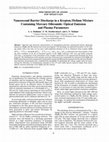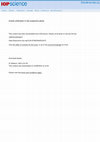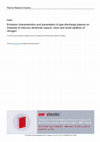Papers by Alexandr Malinin
The results of studies of dielectric-barrier discharge (DBD) plasma optical characteristics in mi... more The results of studies of dielectric-barrier discharge (DBD) plasma optical characteristics in mixtures of mercury diiodide vapor, xenon and helium are presented. Regularities in spectral, temporal and energy characteristics of plasma, depending on the partial pressures of the mixture components are established. An average and pulsed radiation power of 0.8 Watts and 293 Watts is reached respectively from the emission volume 111ˑ10-6 m3 in violet-blue spectral range.
Journal of Applied Spectroscopy, 1980
Soviet Journal of Quantum Electronics, 1983
An investigation is conducted of the process of dissociative excitation of the B 2 Sigma (1/2) + ... more An investigation is conducted of the process of dissociative excitation of the B 2 Sigma (1/2) + states of metastable HgCl, HgBr, and HgI which have been produced as a result of collisions of low-energy electrons with HgCl2, HgBr2, and HgI2 molecules. The obtained results indicate that the process of dissociative excitation of the considered states by electron impact is highly efficient. The cross sections of this process are found to have maxima at low electron energies. The results of the measurements were used in the calculation of the principal characteristics of a plasma and of the kinetics of the processes occurring in gas-discharge lasers utilizing HgBr2-He(Ne) and HgBr2-He(Ne)-N2 mixtures.
An investigation was made of the process of excitation of HgClâ, HgBrâ, and HgIâ molecules by ele... more An investigation was made of the process of excitation of HgClâ, HgBrâ, and HgIâ molecules by electron impact producing B²..sigma../sup +/ââ states of HgCl*, HgBr*, and HgI*. The maximum values of the cross sections for dissociative excitation were found at low electron energies; the values of these cross sections were sigma = (6 +- 3) x 10â»Â¹â¸, (7.5 +- 3) x 10â»Â¹â·, and (1.2 +- 0.6) x 10â»Â¹â· cm² for HgCl*, HgBr*, and HgI*, respectively. The role of such dissociative excitation in lasing was analyzed.
Journal of Applied Spectroscopy, 1989
Coronal and spark discharges are employed primarily for preionization in electric discharge CO 2 ... more Coronal and spark discharges are employed primarily for preionization in electric discharge CO 2 and excimer high-pressure lasers [I, 2]. A free spark discharge is most efficient, since it gives a comparatively high starting electron density owing to photoionization of the gas by UV radiation. In excimer lasers based on halides of inert gases strong preionization substantially increases the uniformity of the transverse volume discharge and determines its margin of stability.

Optics and Spectroscopy, 2015
Spectral and electrical characteristics of atmospheric pressure nanosecond barrier discharge plas... more Spectral and electrical characteristics of atmospheric pressure nanosecond barrier discharge plasma in a HgBr 2 /Kr/He mixture have been investigated. The discharge was initiated by positive 10 kV volt age pulses with a rise time of 4 ns and a half amplitude duration of 28 ns. Emission from exciplex HgBr and KrBr , C 3/2-AΠ 1/2 , D 1/2-AΠ 1/2) molecules have been studied. From the time evolution of the B-X transition spectra of the HgBr molecule (502 nm) and KrBr molecule (207 nm), a mechanism of the formation of the exciplex molecules in the nanosecond discharge has been deduced. The distributions of the energies and rates of the processes responsible for emission from HgBr and KrBr molecules have been analyzed by numerically solving the Boltzmann equation for the electron distribu tion function. Experiments have confirmed the possibility of optimizing the voltage supply pulse for maxi mizing the efficiency of simultaneous emission in the UV and visible (green) spectral ranges from atmo spheric pressure discharge in the HgBr 2 /Kr/He mixture.
Journal of Applied Spectroscopy, 2012
The spectral characteristics of the emission in the 140-315 nm range from pulsed-periodic capacit... more The spectral characteristics of the emission in the 140-315 nm range from pulsed-periodic capacitive discharges in mixtures of water vapor and helium and argon are described. In the VUV the most intense bands have maxima at λ = 156.0, 180.3, and 186.0 nm, and in the region of 300-315 nm, at λ = 312.1 and 313.4 nm. The brightness of the emission from the capacitive discharge plasma is optimized with respect to the partial pressures of helium, argon, and water vapor. The electron kinetic coefficients of discharges in argon and water vapor mixtures are calculated for E/N = 1-1000 Td.

Quantum Electronics, 2005
A 6-dimensional grand unified theory with the compact space having the topology of a real project... more A 6-dimensional grand unified theory with the compact space having the topology of a real projective plane, i.e., a 2-sphere with opposite points identified, is considered. The space is locally flat except for two conical singularities where the curvature is concentrated. One supersymmetry is preserved in the effective 4d theory. The unified gauge symmetry, for example SU(5) , is broken only by the non-trivial global topology. In contrast to the Hosotani mechanism, no adjoint Wilson-line modulus associated with this breaking appears. Since, locally, SU(5) remains a good symmetry everywhere, no UV-sensitive threshold corrections arise and SU(5)-violating local operators are forbidden. Doublettriplet splitting can be addressed in the context of a 6d N = 2 super Yang-Mills theory with gauge group SU(6). If this symmetry is first broken to SU(5) at a fixed point and then further reduced to the standard model group in the above non-local way, the two light Higgs doublets of the MSSM are predicted by the group-theoretical and geometrical structure of the model.
Quantum Electronics, 2013
Optical characteristics of a coaxial HgBr excilamp on multicomponent mercury dibromide vapour mix... more Optical characteristics of a coaxial HgBr excilamp on multicomponent mercury dibromide vapour mixtures with helium, nitrogen and sulfur hexafluoride are investigated under pumping by a pulse-periodic barrier discharge. Stable excilamp operation was demonstrated at a pump pulse repetition rate of 3-9 kHz. The component composition of the working system was determined, which provides a maximal average and pulsed specific radiation power of 48.8 mW cm-3 and 40.6 W cm-3 , respectively, at the efficiency of 7.3 % in the blue-green spectral range with the maximal radiation intensity at the wavelength of 502 nm. The reduction in the radiation power after 2.5 ´ 10 6 shots is 5 %. Interpretation is given for the results of optimisation of excilamp characteristics.

Plasma Physics Reports, 2013
The results of studies of the optical characteristics and parameters of dielectric barrier discha... more The results of studies of the optical characteristics and parameters of dielectric barrier discharge (DBD) plasma on a mixture of mercury dichloride vapor, neon and a small addition of nitrogen, which was the working medium of exciplex gas-discharge radiator which design differed from coaxial, are presented. Electron energy distribution functions, transport characteristics, specific discharge power losses on electronic processes, electrons' concentration and temperature, as well as rate constants of elastic and inelastic electron scattering on components of the working mixture, depending on the value of the reduced electric field strength were established. Based on the data of optical characteristics and plasma parameters, a mechanism is proposed for the excitation of mercury monochloride exciplex molecules, which are the source of emission of a spectral band in the blue-green spectral range with a wavelength of maximum intensity (λ max) 557 nm.

Optics and Spectroscopy, 2009
ABSTRACT The ultraviolet (UV) radiation from longitudinal glow-discharge plasma in three- and fou... more ABSTRACT The ultraviolet (UV) radiation from longitudinal glow-discharge plasma in three- and four-component mixtures of argon, krypton, and xenon with chlorine has been investigated. The total radiation of Ar, Kr, and Xe monochlorides and chlorine molecules in the spectral range 170–310 nm has been optimized with respect to the composition and the pressure of gas mixtures, as well as the discharge current. The mean output power, the electric power of discharge, and the efficiency of a broadband low-pressure exciplex halogen lamp have been determined. Parameters of the glow discharge in Ar-Kr-Cl2 and Kr-Xe-Cl2 mixtures have been simulated numerically. The electron energy distribution functions have been determined through the solution of the Boltzmann kinetic equation. These functions have been used to calculate the plasma parameters, namely, electron transfer characteristics, specific losses of discharge power for electronic processes, and ionization and attachment coefficients.
Instruments and Experimental Techniques, 2006
ABSTRACT A gas-discharge excimer radiation source in the visible spectral region has been develop... more ABSTRACT A gas-discharge excimer radiation source in the visible spectral region has been developed on the basis of a mixture of cadmium diiodide vapors and helium excited by a repetitively pulsed barrier discharge. The source radiation spectrum consists mainly of superimposed spectral bands of emission of cadmium iodide in the range 470–700 nm. The mean radiation power from the source surface (114.5 cm2) is 55 W, the pulse power is 105 kW, and the efficiency is ∼10%. Approximately 90% of the radiation power is concentrated in the red region, which is much higher than in high-pressure sodium lamps at comparable energies deposited into the working mixtures. Such sources can be used to efficiently control photosynthesis and the growth and development of plants and algae.

Uploads
Papers by Alexandr Malinin